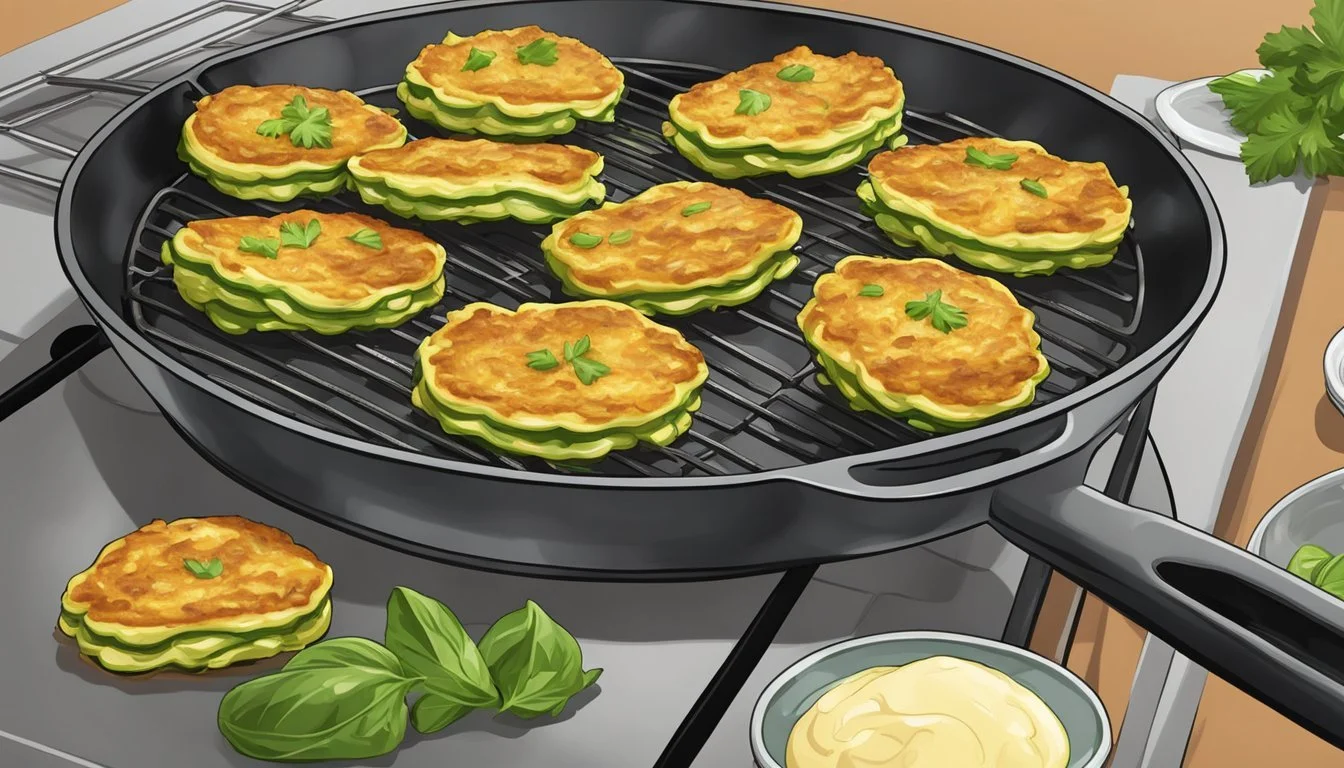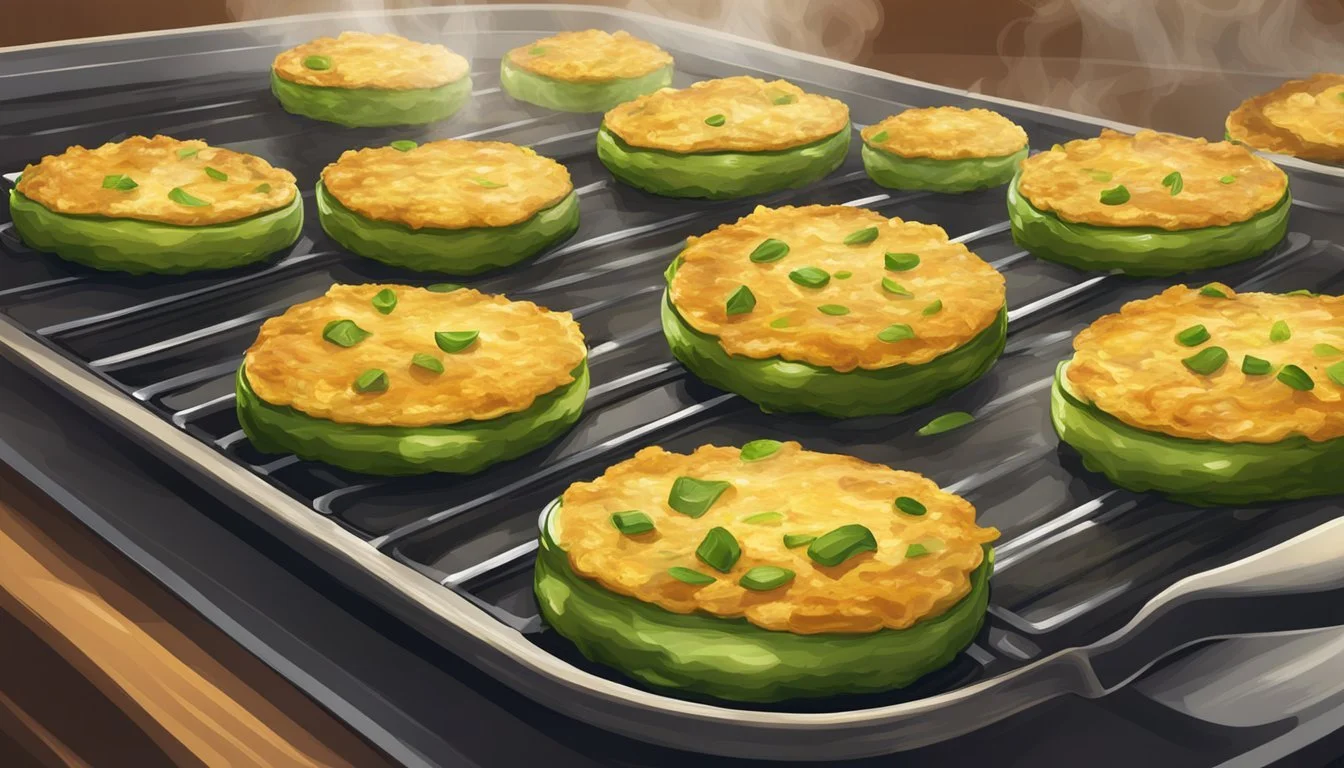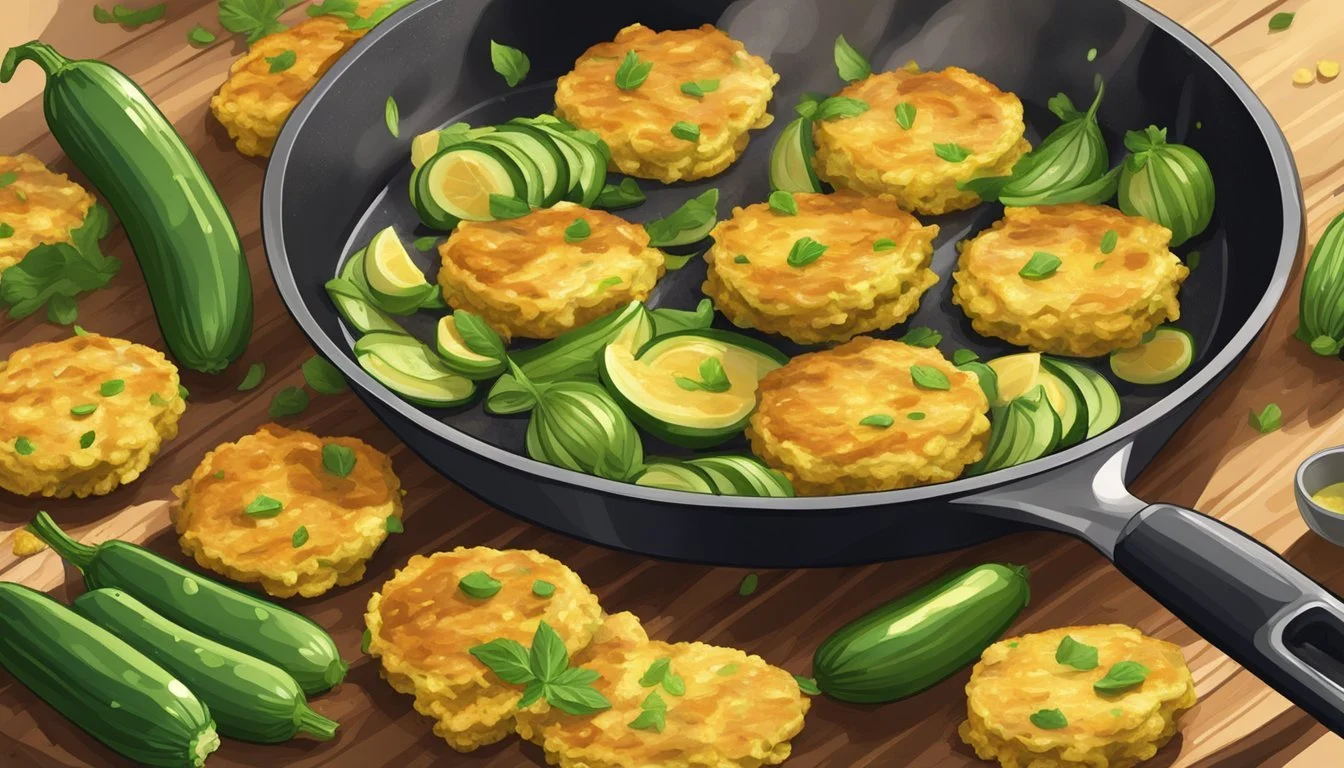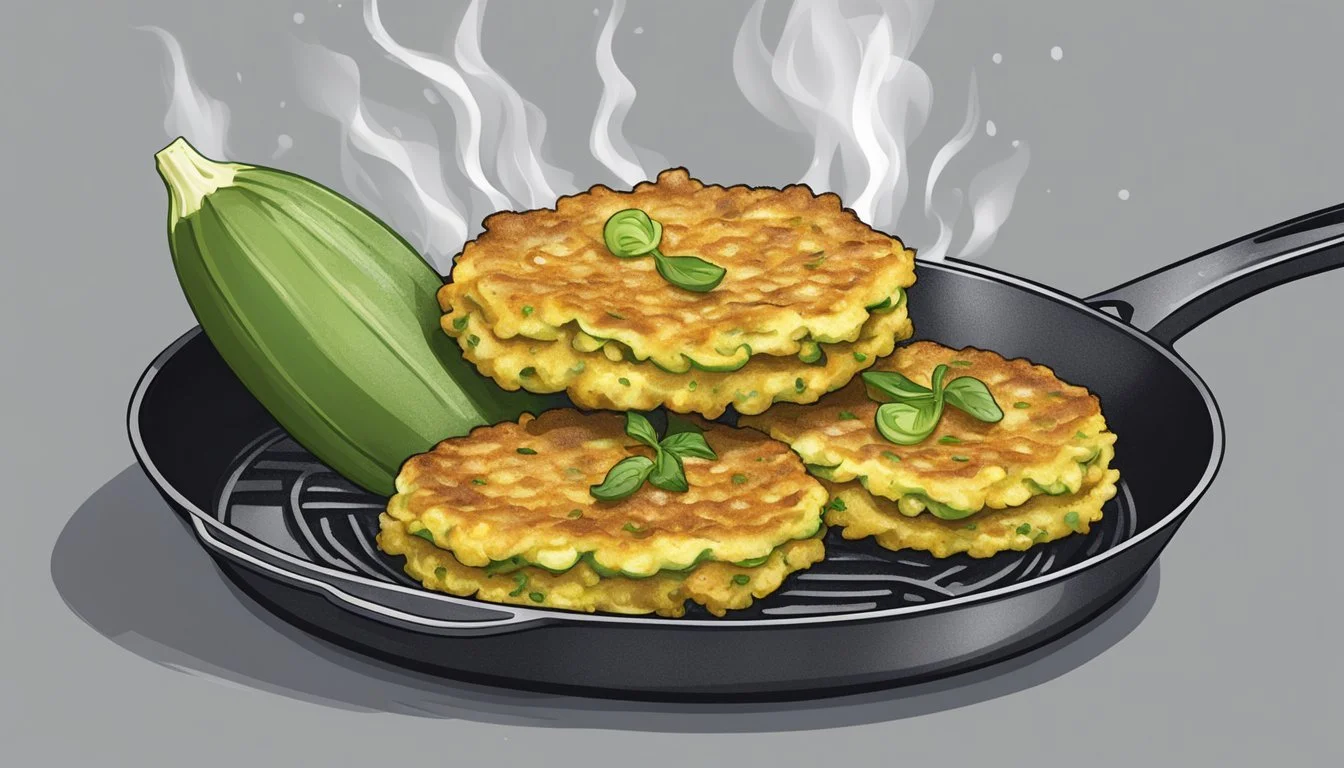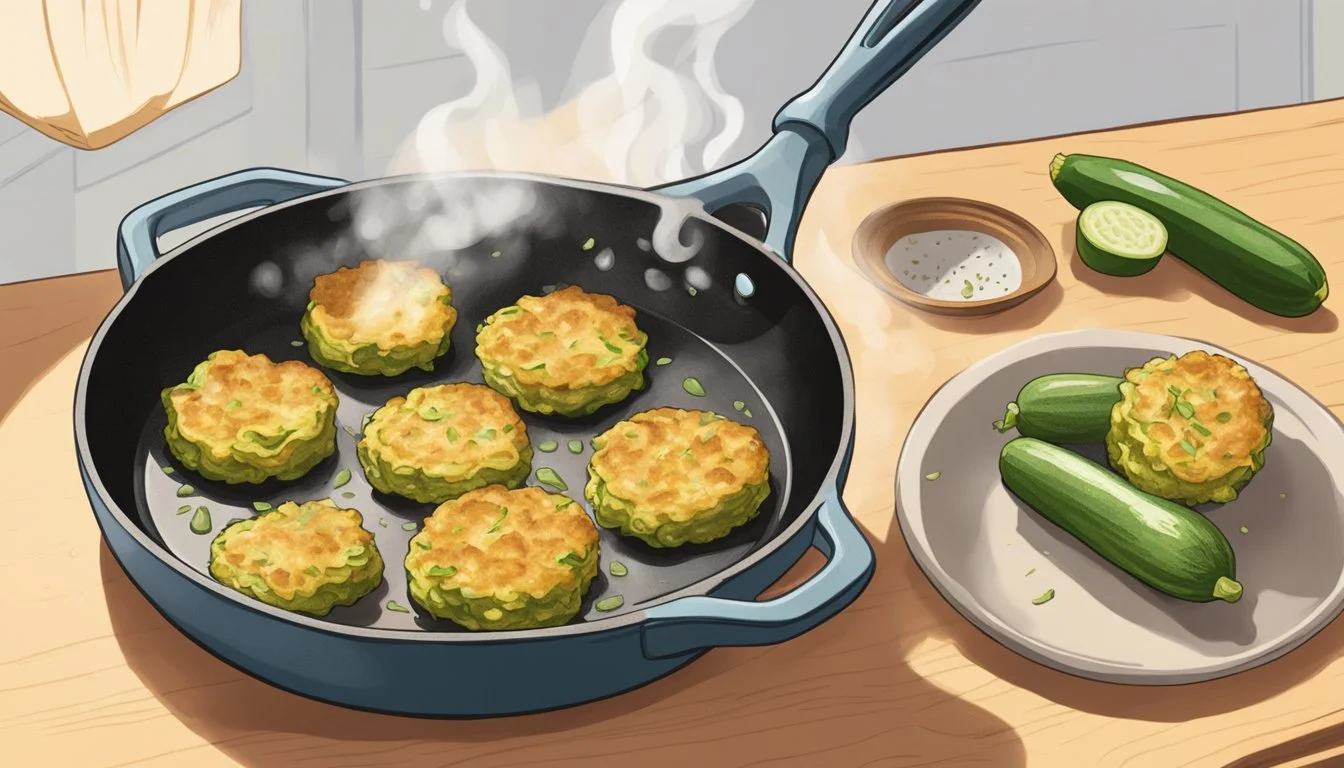Best Way to Reheat Zucchini Fritters
Crispiness and Flavor Preservation Techniques
Zucchini fritters offer a delightful balance between a crispy exterior and a moist, flavorful interior, making them a popular dish that works well as an appetizer, side dish, or even a light meal. Maintaining that perfect texture upon reheating can often seem daunting, as the risk of the fritters becoming soggy or losing their savory edge is high.
The key to reviving leftover zucchini (What wine goes well with zucchini?) fritters lies in the method used to reheat them. Traditional reheating techniques may not preserve the textural contrasts that define a freshly cooked fritter. A certain finesse is required to ensure that reheated zucchini fritters are just as crisp and delicious as when they were first made.
A successful reheating process not only brings warmth to the fritters but also reinvigorates their exterior crispness without compromising the tender, herb-infused zucchini flavor that makes them so appetizing. It's a fine balance to strike, and understanding the best approaches can turn leftover zucchini fritters into a repeat performance worth savoring.
Understanding Zucchini Fritters
In exploring the essence of zucchini fritters, one encounters a savory delight crafted from simple ingredients which, when combined, offer a nutritionally valuable and flavorful experience.
The Makings of a Zucchini Fritter
A zucchini fritter is a small, typically round cake made from shredded zucchini mixed with flour, Parmesan cheese, green onions, and eggs. These ingredients serve as the base, providing both structure and flavor. Often, chefs add fresh herbs and baking powder to enhance taste and achieve a light, airy texture. Here's a typical ingredient list:
Shredded zucchini
All-purpose flour
Grated Parmesan cheese
Chopped green onion
Beaten eggs
Fresh herbs (dill, parsley, or chives)
Baking powder
Salt and pepper to taste
These fritters are versatile and can be customized with additional spices or ingredients based on personal preference.
Nutritional Value and Calorie Content
Zucchini fritters are often enjoyed for their delightful taste without compromising on nutrition. Zucchini, the main vegetable component, is low in calories and contains valuable nutrients such as vitamin A, potassium, and fiber. When other elements like eggs, Parmesan cheese, and flour enter the equation, the protein content and calorie count increase. Here is a simple nutritional breakdown of a standard zucchini fritter:
Nutrient Approximate Value per Fritter Calories 60-100 kcal Protein 3-5 g Carbohydrates 8-12 g Dietary Fiber 1-2 g Fats 3-6 g
These values may vary depending on recipe variations and cooking methods. The presence of Parmesan cheese adds calcium but also contributes to the fritter's calorie and fat content. Despite these additions, when enjoyed in moderation, zucchini fritters can be a tasty part of a balanced diet.
Pre-Reheating Tips
Ensuring that zucchini fritters remain crispy and flavorful upon reheating starts well before they're placed back in the heat. Proper storage and preparation are critical steps that affect the outcome of the reheated fritters.
Proper Storage Techniques
Refrigerator: To keep fritters fresh, they should be stored in the refrigerator within two hours of cooking. For optimal results, they should be placed in an airtight container with a layer of paper towels at the bottom to absorb any excess liquid. This helps maintain their crispiness by preventing them from becoming soggy.
Separation: Place a sheet of parchment or wax paper between each fritter to prevent sticking.
Freezer: If fritters need to be stored for an extended period, freezing is an option. Arrange the fritters in a single layer on a baking sheet and freeze until solid. Once frozen, transfer them to a freezer-safe bag or container for up to three months.
By following these tips, one can enjoy zucchini fritters that are as close to their freshly cooked state as possible, even in the heart of summer.
Preparing Fritters for Reheating
Before reheating, let the fritters come to room temperature for a few minutes to ensure even heating. This also reduces the chances of the fritters becoming tough.
Oven/Toaster Oven: Preheat the oven before placing fritters inside. For those using a toaster oven, adjust the temperature slightly higher due to its smaller size.
Paper Towels: Patting the fritters dry with paper towels can help remove any moisture that has accumulated during storage.
By following these pre-reheating tips, one sets the stage for zucchini fritters to regain their maximum flavor and crispiness.
Reheating Methods for Best Results
When reheating zucchini fritters, the goal is to restore their crispy texture and preserve their savory flavor. Each method has its own set of benefits and drawbacks, depending on the kitchen tools at hand and the time available.
Using the Oven
To use the oven, one should preheat it to 350°F (175°C). Place the fritters on a non-stick baking sheet lined with parchment paper to prevent sticking. Heat the fritters for about 10 minutes, flipping them halfway through to ensure even crispiness. This method heats the fritters evenly, reducing the risk of them becoming soggy.
Stovetop Skillet Technique
For the stovetop skillet technique, heat a skillet over medium heat with a thin layer of vegetable oil. Once the skillet is hot, add the fritters and cook for 2 to 3 minutes on each side until they reach a golden-brown color and regain their crispy exterior. A non-stick skillet can prevent sticking and help achieve an even cook.
Microwave: Pros and Cons
Using a microwave is the quickest way to reheat fritters but often yields the least crispy results. Place the fritters on a microwave-safe plate and heat for 30 seconds to a minute. While the microwave reheats quickly, it also tends to make fritters moist and soggy, compromising their texture.
Air Fryer for Crispiness
An air fryer can achieve a crispy texture similar to the original cooking method. Preheat the air fryer to 350°F (175°C). Place the fritters in the basket in a single layer, ensuring they're not touching. Heat for 3-4 minutes until they're hot and crispy. This method circulates hot air around the fritters, drying out the exterior for a crisp finish.
Serving Suggestions
When serving reheated zucchini fritters, one can enhance their meal experience by choosing the right proteins, sides, and dips. Thoughtful pairing not only elevates the taste but also turns this crispy appetizer into a well-rounded meal.
Pairing with Proteins and Sides
Zucchini fritters pair delightfully with a range of proteins and sides.
Chicken: Grilled or roasted chicken (What wine goes well with roasted chicken?) is a classic choice that complements the fritters' texture.
Salmon: For a pescatarian option, one can serve alongside a piece of seared or baked salmon for a dose of omega-3s.
As for sides, one might want to consider:
Salad: A fresh green salad with vinaigrette dressing balances the richness and adds a necessary crunch.
Cheese: Incorporate cheese such as feta or goat cheese into the salad to add a creamy textural contrast.
Sauces and Dips Enhancements
The right sauce or dip can elevate zucchini fritters from good to great. Here are a few suggestions:
Sour Cream: A dollop of sour cream works wonders, especially when mixed with herbs and a hint of garlic.
Green Onions: For extra zest, finely chop some green onions and sprinkle them atop the sour cream.
Remember, homemade dips always add a personal touch and often taste better than store-bought options.
Alternate Zucchini Dishes
While zucchini fritters are a delightful treat, there are numerous other dishes that harness the versatility of zucchini as a summer squash, ranging from sweet to savory options. These dishes often celebrate the tender, healthy profile of zucchini and are easy to make, making them excellent additions to the dining table.
Creative Twists on the Classic Fritter
One can get innovative with fritters by incorporating zucchini into different types of batter for a variety of textures and flavors. A popular variant is the zucchini bread, a sweet counterpart to the savory fritter. It bakes the squash into a moist, tender loaf that's ideal for breakfast or snacking. The recipe for zucchini bread frequently includes nuts or spices, adding a complex flavor profile to an otherwise simple dish.
Exploring Other Zucchini Recipes
Beyond fritters and bread, zucchini proves its versatility in recipes like stuffed zucchini boats. These boats are a wholesome and flavorful dish where the zucchini acts as a container for a variety of fillings, be it cheese, grains, meats, or other vegetables. It is a creative way to present vegetables and can make a compelling main course.
For those seeking to keep track of their favorite zucchini preparations, creating a recipe card collection is an excellent way to organize these dishes. Whether they are looking to make a quick summer meal or use up the abundance of zucchini from their garden, home cooks will find that zucchini plays well in a host of recipes, contributing to its reputation as one of the garden's most versatile veggies.
Top Tips and Tricks for Perfect Fritters
When one aims to reheat zucchini fritters, maintaining their crispiness and taste is paramount. The following guidelines serve as a roadmap to ensure that every fritter reheated is as delightful as it was freshly cooked.
Achieving the Perfect Texture
Cooking Method: The best way to reheat fritters is in a skillet over medium heat. One can employ the oven as well, especially for larger batches, by placing the fritters on a wire rack in the oven at 350°F for about 10 minutes.
Handling Moisture: Zucchini contains a lot of water, which can lead to soggy fritters. It is essential to remove the excess water before cooking by salting the grated zucchini and letting it sit in a colander. Then, squeeze out the water either by hand or with a clean kitchen towel.
Binding: To ensure the fritters stay together and don't fall apart when reheating, it's important to have the right binders. Eggs and breadcrumbs work effectively, along with a touch of flour, to create the perfect consistency that holds even upon reheating.
Freezing: If one intends to store zucchini fritters for an extended period, freezing them is an option. Once cooked and cooled, fritters should be laid out on a baking sheet, not touching, and frozen until solid before being transferred to a freezer-safe bag or container.
Flavor Enhancements
Cheese: Incorporating grated parmesan cheese or mozzarella into the fritter mixture can add a flavorful punch and also contribute to the binding aspect to prevent the fritters from breaking apart during reheating.
Herbs and Spices: Fresh or dried parsley, chives, and other herbs can elevate the flavor profile. When adding to the mixture, ensure that they are finely chopped to distribute flavor evenly.
Fat Content: For a richer flavor, one can mix a small amount of fats like olive oil or melted butter into the batter before cooking. This can also help the fritters crisp up more when reheated.
By applying these precise tips and techniques, one can enjoy perfectly textured and flavorful zucchini fritters, whether they're fresh out of the pan or reheated for a later meal.
Troubleshooting Common Issues
When reheating zucchini fritters, one might encounter issues such as sogginess or uneven cooking. Addressing these problems ensures that the fritters retain their crispy texture and flavorful profile.
Dealing with Sogginess
A soggy zucchini fritter can disappoint, as it lacks the appealing crunch that contrasts its moist interior. To prevent sogginess:
Drain Excess Moisture: After grating the zucchini, one should always thoroughly drain the excess liquid, which can be done by squeezing the grated zucchini in a clean cloth or using a colander with a weight on top.
Use the Right Fat: Employing an appropriate amount of fat, such as cooking oil or butter, can help the fritters crisp up during the reheating process. Be careful to not use too much, as this can lead to greasiness.
Batter Consistency: The batter should be of the right consistency before cooking the fritters. If it's too wet, add a bit more flour or breadcrumbs to absorb the excess moisture.
Ensuring Even Cooking
To achieve an even, golden-brown crust on reheated zucchini fritters, consider these tips:
Oven Reheating: Spread the fritters in a single layer on a wire rack set over a baking sheet and reheat at 350°F for a uniform heat distribution.
Pan Method: If using a pan, ensure it's heated to a medium temperature before adding a small amount of oil. Flip the fritters regularly to heat each side evenly.
Adding Cheese: If the fritter recipe includes cheese, using a cheese that melts well can help create a seal around the fritter, warding off moisture penetration and contributing to an even cook.
Following these solutions can mitigate common reheating issues, maintaining the quality of your zucchini fritters.

